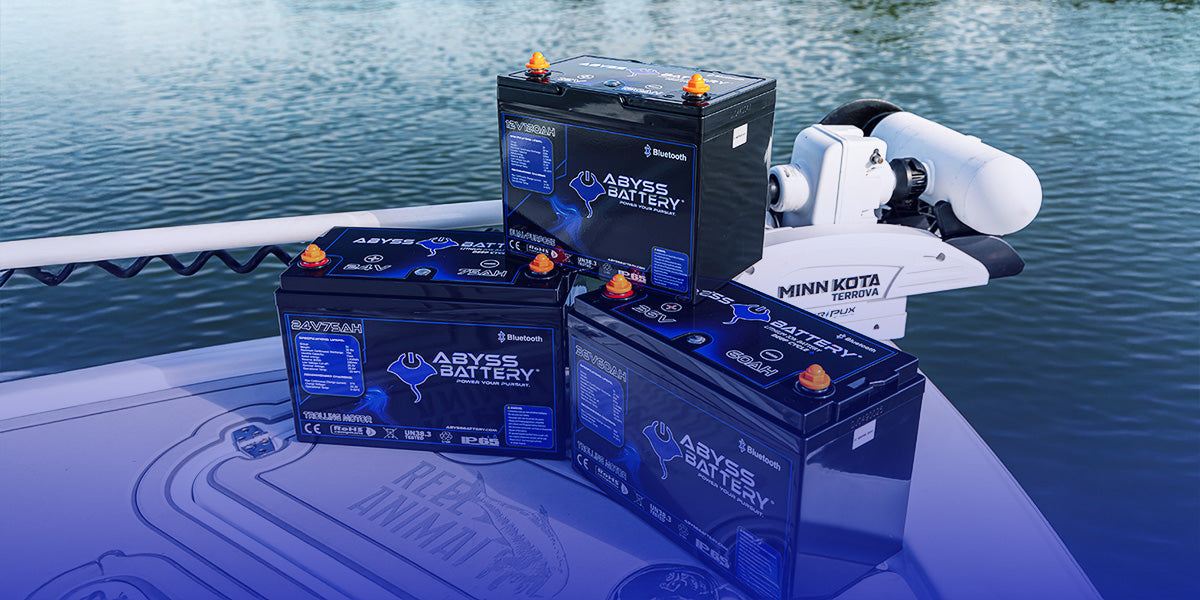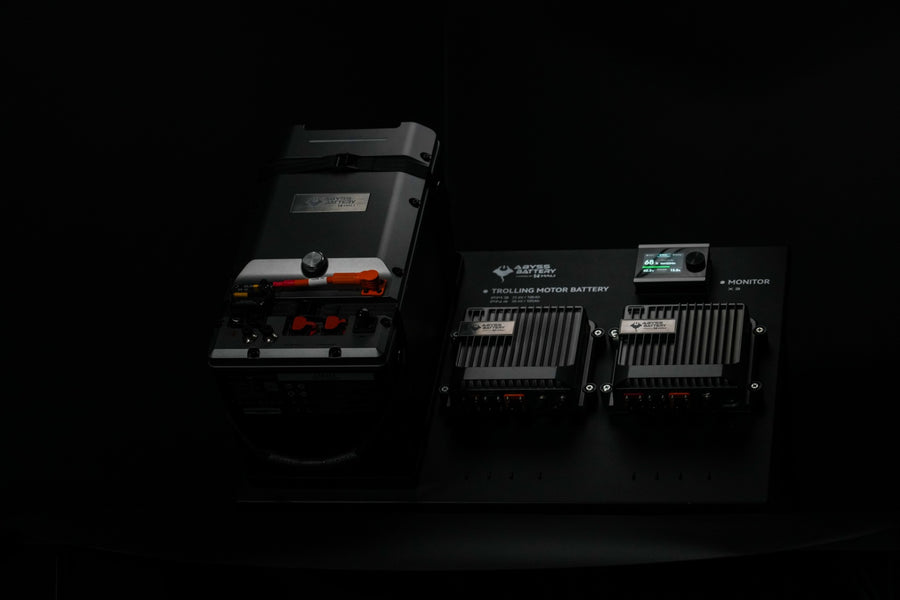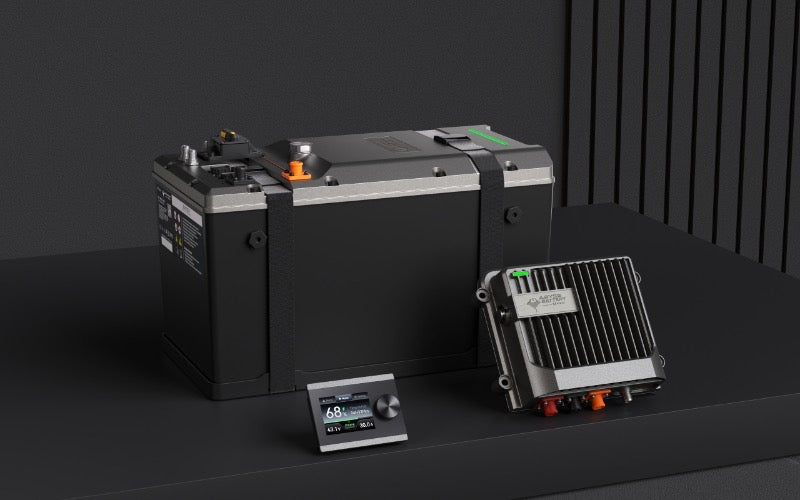The Ultimate Guide to Lithium Marine Batteries

Investing in a lithium battery for your trolling motor is one of the best ways to enhance your boat's performance, spend more hours on the water, and improve your environmental impact. Lithium batteries have a greater energy density than absorbent glass mat (AGM) and flooded lead acid (FLA) batteries, delivering more reliable power and enhanced longevity. Choosing the right lithium battery and charger is important for optimizing your boat's power output, safety, and efficiency.
Benefits of Lithium vs. AGM and FLA Marine Batteries
Lithium batteries offer the following advantages over AGM and FLA batteries:
Longer Runtimes and Reduced Fuel Costs
A lithium battery's energy density enables it to store more energy than an AGM battery. This results in longer runtimes between charges, giving you extended range and more time on the water. Lithium batteries are also lighter than other batteries, which reduces your boat's overall weight. This advantage improves efficiency and speed while helping you reduce fuel consumption costs.
Greater Longevity
Lithium marine batteries tend to last much longer than FLA and AGM batteries. Exact charge cycles can vary based on brand and how well you maintain your battery, but a lithium battery offers a significantly longer lifespan than its alternatives. This longevity results in more value for your investment, reducing the number of replacements you need to purchase in the future.
Dependable Power
When you use a lithium battery, you can expect full, dependable power for almost the entire discharge cycle. Lithium batteries maintain a stable voltage throughout their discharge cycles, unlike the gradual voltage drop that occurs in FLA and AGM batteries. Rather than reducing performance as it discharges, a lithium battery delivers optimal performance until it's due for another charge.
Safer Charging
Built-in safety mechanisms protect a lithium battery while it charges. These safety mechanisms prevent overheating, over-charging, and over-discharging as long as you use a compatible charger.
Lower Environmental Impact
A lithium battery lacks the lead and sulfuric acid found in FLA and AGM batteries, and its design safely seals its inner parts. This protects the water from damaging metals and chemicals, preventing marine ecosystem pollution. You can also reduce waste with a lithium battery because its longevity decreases the number of replacements you need.
How to Choose a Lithium Battery for Your Boat
Choosing the right lithium marine battery for your boat enhances safety and reliable battery operation. Consider the following factors when choosing a replacement battery:
Size and Capacity Requirements
Measure your boat's battery storage space to ensure you choose a battery that fits your boat. It's also important to consider the necessary energy capacity based on the following factors:
- Engine requirements: Check your engine's manual for the operating amperage draw and the marine cranking amps (MCA), which indicate the recommended starting amperage rating.
- Electrical devices: List all of the electrical devices you use on your boat, such as fish finders, navigation equipment, and lights. Refer to each device's manual to find the amperage or wattage it draws from a battery.
- Daily usage: Multiply each device's power consumption by the number of hours you use it per day. Add these numbers together to determine how much amperage your boat needs daily.
Amp Hours

Once you understand your boat's power consumption, you can determine the ideal amp-hour rating. A battery's amp hours (Ah) indicate its energy storage capacity or how much power it can deliver per hour. For example, a 3,200 mAh rating enables a battery to discharge 3.2 amps or 3,200 milliamps per hour. It's also important to check your boat's owner's manual for the recommended battery amperage.
Voltage Compatibility
Matching a battery's voltage to your boat's voltage requirements is vital for longevity, performance, and safety. A battery's voltage rating indicates how much pressure it delivers to push an electrical current through a circuit. Check your boat's owner's manual for its capacity and compatible voltage. A smaller boat may operate on a 12-volt (V) battery, while a larger boat may operate on a 24V or 36V battery to support a more powerful trolling motor.
Safety and Monitoring
As previously mentioned, a lithium battery's built-in safety features protect it from damage. For optimal protection, it's best to look for a model with a battery management system (BMS). A lithium marine battery with a BMS enhances protection with the following capabilities:
- Temperature monitoring: Temperature sensors can detect if a battery overheats and reduce the charging current to regulate the battery's temperature during charging.
- Current and voltage regulation: A BMS regulates currents and voltage so they don't become too high and cause damage.
Lithium Boat Battery Installation and Maintenance
Use the following installation and maintenance tips to optimize your lithium marine battery's performance, efficiency, and longevity:
- Secure mounting: Mount your battery securely to ensure it remains stationary during operation. It should be in a designated compartment, and you can secure it with straps or mounting brackets if necessary.
- Ensure proper ventilation: Ensure your battery has adequate ventilation to prevent overheating.
- Schedule professional installation: Unless you have experience installing lithium batteries, it's best to schedule professional installation.
- Connect to a BMS and Bluetooth: Purchasing a BMS and a lithium marine battery with Bluetooth monitoring is the easiest way to track your battery's condition and prevent damage.
- Use a compatible charger: Ensure your charger's amperage and voltage match your battery's specifications.
- Recharge after each use: Recharging your lithium battery after each use helps prevent deep discharge from occurring.
- Avoid over-charging: Avoid overcharging your battery to prevent degradation and extend its lifespan. It's best to use a charger that automatically stops once it detects a full charge.
- Store the battery properly: Store your lithium battery at a partial charge in a cool, dry place out of direct sunlight. Periodically charge it while it's in storage, especially if you store it for a prolonged period.
- Allow long discharges: Deep cycle batteries can handle longer discharge cycles than AGM and FLA batteries. You can discharge your lithium battery down to a low charge before recharging.
Enhance Your Boat's Performance and Longevity With a Dependable Lithium Marine Battery
A lithium battery enables you to enjoy more hours on the water and contribute to healthier waterways. Abyss Battery® offers high-quality lithium batteries for a wide range of applications. Our Trolling Motor Lithium Batteries and 12-Volt Dual-Purpose Lithium Marine Batteries elevate your experience out at sea.
Our smart batteries surpass the typical lithium battery's capabilities with advanced technology. Integrated artificial intelligence (AI) learns from your usage patterns to automatically optimize performance and gradually improve. Whether you hit the water for fun or participate in high-stakes tournaments, investing in a lithium marine battery from Abyss Battery gives you a strategic advantage. Browse our collection of lithium batteries to learn more about enhancing your boat's power, longevity, and eco-friendliness.






Leave a comment